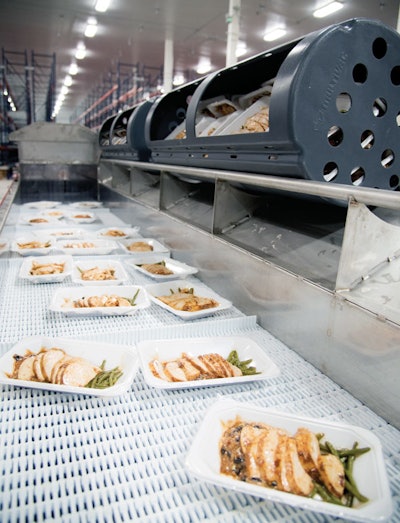Packaged food that combines convenience and wholesomeness, that is minimally processed and additive-free, and that is capable of a refrigerated shelf life permitting national distribution. That’s what a whole lot of food manufacturers are after these days, which explains the growing interest in High Pressure Processing (HPP).
HPP is a cold pasteurization technique by which product sealed in its primary packaging is subjected to a high level of isostatic pressure transmitted by water. HPP inactivates bacteria, yeasts, parasites, and molds in food in much the same way that thermal processing methods like retorting or aseptic processing do. The advantage of HPP is that most thermal processing technologies have a more negative impact on flavor and nutritional properties than HPP.
A relative newcomer to the short list of suppliers offering HPP is Multivac. Its first installation: Texas Food Solutions, a startup company just outside Houston, TX. The launch of TFS was a natural extension of the rapid growth of sister company Perfect Fit Meals (see pwgo.to/1955). Perfect Fit has been producing and selling fully cooked ready meals in vacuum skin packs through refrigerated channels for several years now. But for HPP, Perfect Fit has had to rely on an outside toll processor. By now relying instead on sister company TFS, the economics and overall efficiency of HPP are greatly improved. TFS, of course, will operate as a toll processor for plenty of other food companies in need of HPP.
According to TFS President Jasmine Sutherland, taking HPP in house was attractive primarily because doing so made it “an extension of our process.” Quality issues, she adds, were a potential concern as long as quality control wasn’t being managed 100% in house.
“Quality and safety have to come first,” she says. “Building volume and developing new and interesting products are great, but our first and most constant thoughts revolve around quality and safety. As we started talking with other food marketers like us who were relying on toll processors for HPP, we started to realize that there was a real opportunity for us to expand into this. It was really a natural progression. We went pretty quickly from thinking about buying one HPP system and putting it in our food processing facility to building a new facility for our first HPP system and planning for the installation of a second HPP system. The market for this kind of refrigerated shelf life extension technology is growing, and we felt we could be very good at it.”
Among the advantages gained by bringing HPP in house is an ability to experiment, fine-tune, modify, and innovate in a way that would never be possible if HPP was still being done by an outside party.
“Rapidly iterating prototypes is not something you can do efficiently when you don’t control your own machine,” says Sutherland. “With this new plant in the picture we can experiment all we want with food in cups, trays, bags, bottles, vacuum skin pack, or MAP. It’s this ability to experiment that led us to include a test kitchen and innovation center.”
Oil rig or mezzanine?
Being just outside Houston as they are, where oil and gas production is such a big part of the local scene, TFS took a regionally-flavored approach to designing and engineering its HPP processing line. Electrical panels, hydraulic pumps, water systems, and just about everything else that controls the HPP system is mounted on a mezzanine-level superstructure that looks more like an off-shore oil rig than a food-plant mezzanine. The only thing down on the plant floor itself is the HPP unit, the conveying equipment bringing product in and out of HPP, and the secondary and tertiary packaging machines. Sutherland explains why.
“In most traditional HPP installations, one of the most expensive components is high-pressure tubing. Putting the hydraulic pumps directly over the HPP system itself rather than in a separate space or room nearby is the most direct and efficient route that requires the least amount of high-pressure tubing. Uhde helped us a lot with this bit of engineering, which was so important to us. The structure itself was designed by a fabricator who builds off-shore oil platforms, and that’s kind of what he gave us. It will hold 150,000 lb, which means we could have up to four HPP units here and the mezzanine would hold the pumps, control panels, and water systems for all four.”
The Multivac HPP 350 now operating at TFS emerged out of a strategic partnership formed in 2011 between Uhde and Multivac. The actual chamber in which food packs are pressurized comes from Uhde, a German firm that is a recognized authority on HPP. External housing, baskets that hold the primary packages, and conveyors that move the baskets in and out are all in Multivac’s scope of supply.
The process
Packages to be processed are loaded by hand into three injection-molded HDPE baskets. Once all three baskets are full, an automated sequence of actions follows. First, a pneumatically driven rod pushes the baskets into a stainless steel vessel. This vessel is then pushed at a right angle into the Uhde chamber. Next, stainless steel plugs close on the vessel at each end. As soon as the plugs are in, a large stainless steel spacer block moves in behind the plugs at each end.
At this point, water floods the 350-L chamber. Finally, it’s time to build pressure, and this is done by three overhead pumps that create 87,000-psi pressure inside the chamber. Says Sutherland, “The way Uhde described it to me is that the pressure generated is the equivalent of three 747 airplanes stacked on top of each other and all sitting on your iPhone.”
Dwell time inside the chamber varies according to the product and package being processed. For the line of cooked ready meals sold by Perfect Fit Meals, the 8- or 9-oz packages—a protein like chicken or pork, a rice or pasta, and a green vegetable—typically are held under pressure for about three minutes. Then the vessel moves back out of the Uhde chamber, the plugs are opened at each end so the water can drain out, and the three baskets are pushed out by three new baskets that are being pushed in. Then the cycle, which lasts about eight minutes total, repeats.
Another bit of engineering performed by Uhde that Sutherland greatly appreciates involves water usage. “While comparable systems rarely recycle more than 60 or 70% of the water, we are able to recycle 100%,” she points out. “We also soften the water so that it’s easy on the machine components.”
HPP is inherently a batch technology, so the key to reaching any kind of real throughput is to minimize batch cycle time. Loading and unloading the baskets, inserting baskets into the vessel, plugging the vessel, moving the vessel into the Uhde chamber, allowing sufficient dwell time, and moving the vessel back out of the chamber are all parts of the cycle that are pretty much fixed. One part of the cycle, however, that Multivac claims it can abbreviate significantly is the amount of time it takes to build pressure inside the chamber. It involves installing two 350-L systems side by side and then plumbing them in a tandem mode.
“Each 350-L unit has three pumps up in the mezzanine,” says Sutherland. “With the tandem approach you build pressure in one unit and when you reach 87,000 psi you deploy one pump to maintain that pressure for whatever dwell time is called for. At that point—thanks to an arrangement of switching valves, some creative plumbing, and the right programming—the other five pumps are diverted to the other unit. So you’re using five pumps to get up to pressure instead of only three.”
According to Multivac’s Cem Yildirim, tandem is a big deal. “It means your combined throughput is about 20% greater than if the two 350-L units were operating independently,” he points out. “It’s all about decreasing the amount of time it takes to get up to pressure.”
Operators remove the processed packages from the basket and place them on a conveyor that takes them through a drier before they arrive at a Ravenwood Nobac linerless labeler. Operators place the empty baskets on a return conveyor that delivers them back to the place where unprocessed ready meals can be loaded into them.
Secondary packaging is partially automated, including corrugated case erecting, which is done on a Wexxar WF20. Four ready meals are placed by hand into the cases, which then go through a Wexxar/BEL case taper. Just before this taping system is a Videojet print-and-apply labeler that uses a thermal-transfer printer to give each box the variable data it needs. Cases are placed on pallets manually, and then packaging comes to a close with an Orion stretch wrapper.
Materials play a role, too
Extending the shelf life of food products sold through refrigerated channels often involves packaging materials that have barrier properties. The ready meals being produced by TFS are no exception. The Cryovac tray from Sealed Air is a multilayer coextrusion that includes a layer of EVOH for gas barrier properties. And the vacuum skin pack top film is also an EVOH coextrusion. Shelf life on these products is 30 days.
“The general rule of thumb is that you can get up to six times the shelf life with HPP,” says Sutherland. “What we see is organoleptic failure, off colors in green beans, for example, before any kind of microbial numbers become a problem.”
The linerless labels applied by the Ravenwood Nobac machine are notable, too. Sutherland and colleagues gravitated toward them because of the “green” factor—no release liners bound for the solid waste stream—and because the machines allow full wrap, partial, C-wrap, or top label formats.
Another interesting part about the Ravenwood concept that makes it quite unlike conventional pressure-sensitive labeling is that when labels are mounted on the Nobac machine, their orientation is wide side leading. As the roll of labels is unwound, a sensor detects the eye marks on the back and signals the labeler’s Mitsubishi PLC to halt the advance of the label material so that a guillotine-like blade can cut one label from the continuous roll. This label is captured by belts that carry it under a thermal transfer print head from ICE for date coding. The belts then carry the label onto the pack where plows and a top-pressure belt apply it to the package.
Hub Labels is the label converter that supplies Perfect Fit with its linerless labels. Hub first runs an 8-pt paper stock through an eight-color flexo press that delivers UV-curable inks to both the front and back of the label. On the front, of course, are attractive graphics, Nutrition Facts, and heating instructions. On the back in just black is a QR code for consumer feedback purposes plus an eye mark. The printed roll is then fed into a coating system made by Ravenwood that pattern coats the back of the label material with adhesive. The front side gets a silicone release coating in a pattern that matches the adhesive pattern on the back. This is what makes the absence of a release liner possible, because when labels are wound into the roll that will be mounted on the Nobac labeling machine, the only part of the front side that meets with the adhesive on the back is the part that has silicone release coating. Without this coating-to-coating match, the presence of adhesive would make label unwind impossible.
TFS took shipment of its Multivac HPP system in August and has been putting HPP product on store shelves since early October. By the end of October the facility was processing about 40,000 units weekly. With private label contracts now coming in, including one with the well-known supermarket chain Albertson’s, Sutherland says volume in January should be in the range of 80,000 to 90,000 units per week.






















